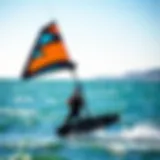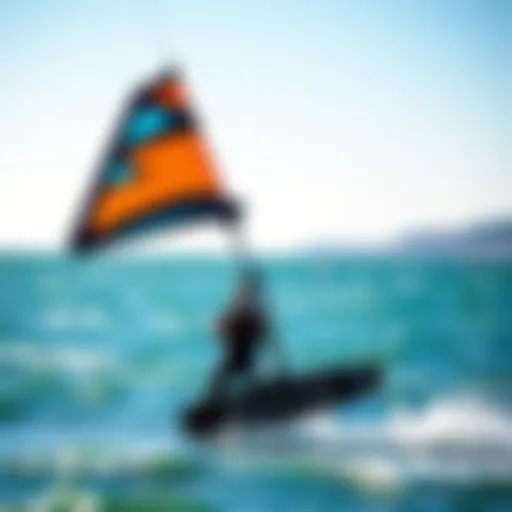Understanding the Lake Erie Marine Forecast
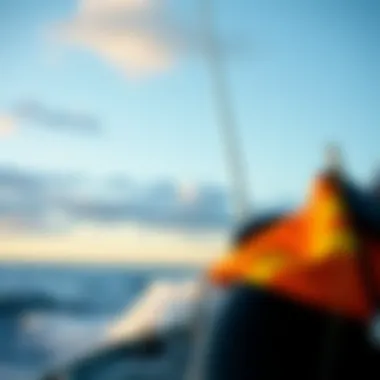

Intro
Navigating Lake Erie isn’t just about knowing how to swim or having a trusty vessel. The waters can be unpredictable, and understanding the marine forecast is crucial for anyone who dares to take to the waves. From the casual paddleboarder to the spirited kiteboarder, everyone can benefit from a solid grasp of what awaits them on the water. Bringing together meteorological data and water conditions, the marine forecast serves as a navigational compass, guiding enthusiasts safely through their aquatic adventures.
What is the Marine Forecast?
At its core, a marine forecast provides vital information about expected weather patterns and water conditions in a specific area. On Lake Erie, this includes wind speeds, wave heights, and even water temperature. For kiteboarders, a big gust can mean soaring high above the water, while a calm breeze may leave you drifting aimlessly. This foresight is essential — it’s not just about getting wet but rather enjoying the experience in a safe manner.
With the right tools and knowledge, kiteboarders can align themselves with the most favorable conditions, optimizing their performance while minimizing risks. It's this blend of education and adventure that keeps the Lake Erie community alive and thriving.
Gear Selection
When it comes to maximizing your time on the water, gear selection can't be ignored. Each component plays a vital role, influencing your safety, comfort, and performance. Choosing the right kite and board tailored to your skill level and the anticipated conditions is a step in the right direction.
Types of Kites
The kite is your lifeline — it powers your ride. Selecting the right one hinges on a few factors:
- Size: The wind’s strength dictates the size kite you need. A larger kite takes advantage of light winds whereas a smaller kite excels in stronger breezes.
- Style: There are different types of kites, like inflatable kites for stability or foil kites for performance. Depending on whether you prefer speed or tricks, you'll want different styles.
- Construction: The material and build affect durability. High-quality kites can withstand harsh conditions, a must when dealing with Lake Erie’s sometimes gnarly weather.
Choosing the Right Board
What you ride has just as much significance. The right board can make or break a session. Here’s what to mull over:
- Board Type: In the realm of kiteboarding, there are twin tip boards, directional boards, and foil boards. Each type offers unique features that cater to different techniques and preferences.
- Rocker Shape: The curvature of the board affects how it rides through waves and wind chop. A pronounced rocker permits easier turns and soft landings.
- Skill Level: A beginner might favor a wider, more stable board, while an advanced rider may seek out something more agile and responsive.
Having the right gear isn’t just about having the flashiest items; it’s about enhancing your connection with the water and, ultimately, ensuring a safer experience.
Skill Development
Once you have the appropriate gear, developing your skills is the next step. Mastery of essential techniques can drastically improve not only your performance but your enjoyment on the water.
Essential Techniques
A few key skills to hone include:
- Launching and Landing: Knowing how to launch and land your kite gracefully can prevent accidents and maximize your time on the water.
- Riding Upwind: Mastering this technique allows you to stay in control and return to your starting point without much hassle.
- Jumping and Tricks: More advanced maneuvers require practice and patience. Start with the basics and gradually build up your confidence and ability.
Progression Tips
Progressing in kiteboarding requires a willingness to learn and adapt:
- Practice regularly to build muscle memory.
- Watch tutorials or join local kiteboarding groups to unlock new techniques.
- Always assess weather conditions before heading out; understanding them can greatly influence your skill development.
"Preparation is the key to safety and enjoyment on the water. Stay informed, stay equipped, and let the waves carry you to new heights!"
Preface to Lake Erie
Lake Erie stands as a vital component of North America's maritime landscape, offering both beauty and utility. This section seeks to unpack the significance of this body of water, enriching our understanding as we explore the marine forecast’s intricacies later on.
Geography and Features
Lake Erie, the fourth largest of the five Great Lakes, covers approximately 9,910 square miles. Its borders stretch across the United States and Canada, with the states of Ohio, Pennsylvania, New York, and parts of Michigan touching its shores.
One of the lake’s defining features is its relatively shallow depth, averaging just 62 feet. This makes it unique among the Great Lakes, influencing both its ecology and maritime traffic. The shallowness allows for quick warming in summer, often leading to significant fog formation that can catch even seasoned sailors off guard. The lake hosts several islands, notably the Bass Islands and Pelee Island, each offering distinct ecosystems and recreational opportunities.
The surrounding landscape plays an important role as well; from the sandstone cliffs along the northern shoreline to extensive wetlands that have developed in regions like the Maumee Bay Area. This diverse geography creates an environment rich in flora and fauna, making it a haven for both wildlife enthusiasts and recreational water users.
Importance of Lake Erie
Understanding Lake Erie’s significance goes beyond appreciating its beauty. For those engaged in water sports, particularly kiteboarding, knowing the lake's characteristics is paramount. Consider its critical role in trade and transportation. Major cities like Cleveland, Toledo, and Erie rely heavily on this waterway for shipping goods, connecting them to larger markets.
Additionally, Lake Erie serves an ecological function, acting as a reservoir of biodiversity. The lake's unique mix of fresh and saline waters nourishes numerous species, from fish to migratory birds, making it a key area for ecological studies as well. Any change in water quality impacts not just the life within but also those who rely on it for recreational activities. As a result, a solid understanding of local marine forecasts becomes crucial for ensuring safety and optimizing performance.
"Knowledge is like the sea; the deeper you dive, the more treasures you find."
This phrase encapsulates the essence of delving into the marine forecast in subsequent sections.
Understanding Marine Forecasts
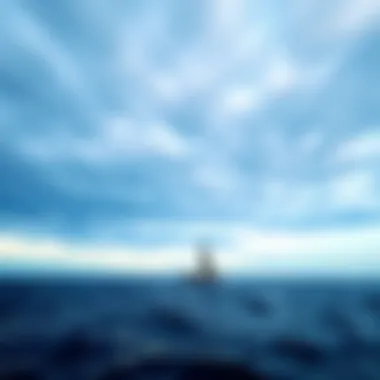

Understanding marine forecasts is an essential part of engaging with Lake Erie, particularly for those involved in water activities like kiteboarding. These forecasts offer a window into the complex interplay of various environmental factors, equipping users with necessary insights for safe navigation and optimal performance on the water. With the right knowledge, kiteboarders, instructors, and event organizers can make informed decisions that mitigate risks and enhance their experiences.
Definition and Purpose
Marine forecasts serve to provide accurate weather predictions specifically for maritime activities. Essentially, they cover a range of variables, including wind speeds, wave heights, and other atmospheric conditions that affect the water's surface. The primary purpose of marine forecasts is to offer timely and precise information to help individuals and organizations ensure safety and effectiveness while they navigate waters like Lake Erie. Understanding these forecasts also translates into making educated choices about when to engage in water sports, thus preventing accidents and unfavorable conditions.
Key Components of Marine Forecasts
Marine forecasts hinge upon several critical components that cater specifically to the needs of those utilizing lakes or oceans. Three major elements stand out: wind predictions, wave heights, and weather patterns.
Wind Predictions
Wind predictions are arguably one of the most vital aspects of marine forecasts. Kiteboarding is heavily influenced by wind conditions, making accurate forecasts essential for both amateurs and veterans alike. A strong, consistent wind can ensure a thrilling ride, whereas erratic winds can introduce significant risks. This variance in wind speed and direction can drastically affect performance, as even a slight change can lead to unstable conditions.
Furthermore, the unique feature of wind forecasts is that they often account for gusts and lulls. Gusty winds can offer sudden bursts of speed, but they can also lead to dangerous surprises if a kiteboarder isn’t well-prepared. On the flip side, having low-wind conditions might seem favorable, but it could hinder performance for experienced kiteboarders looking for thrilling maneuvers.
Wave Heights
Another critical element is the prediction of wave heights. For many water sports enthusiasts, understanding wave dynamics is as crucial as grasping wind conditions. Waves can affect the overall safety and experience significantly. High waves can pose risks, particularly to less experienced operators who might struggle with maintaining control. Conversely, manageable wave heights create an ideal environment for those wishing to enhance their skills.
What sets wave height forecasts apart is their time-specific nature. Waves can change rapidly with shifts in the wind or weather fronts, meaning accurate and timely forecasting is essential. Some kiteboarders thrive on larger waves for acrobatic tricks, but they need to read the forecast properly to avoid dangerous conditions.
Weather Patterns
Lastly, weather patterns represent another pivotal aspect of marine forecasts. These patterns encompass a wide array of meteorological phenomena, from storm systems to clear skies. Often, weather can change at the drop of a hat on large bodies of water like Lake Erie, so keeping tabs on the weather is paramount. The ability to forecast systems approaching the area can greatly enhance safety. For instance, a kiteboarder might look toward a sunny afternoon but fail to recognize dark clouds gathering on the horizon, signaling a change in weather that could lead to a storm.
Weather patterns also play a role in long-term planning. Information about seasonal changes can aid kiteboarding event organizers in determining the best times to schedule competitions, as well as help community members in preparing for heightened activity.
"Incorporating accurate wind, wave, and weather insights can ensure that both performance and safety are maximized during water activities on Lake Erie."
Understanding these key components wind predictions, wave heights, and weather patterns — equips water enthusiasts with the tools necessary for a fulfilling and secure experience out on the lake. With all this knowledge at hand, kiteboarders can look forward to not just fun times, but safe ones too.
Meteorological Data Collection
Meteorological data collection serves as the backbone of understanding marine forecasts, particularly when it comes to Lake Erie. The importance of precise and timely meteorological data cannot be overstated, especially for kiteboarders and other water sports enthusiasts. Having access to high-quality data can spell the difference between a thrilling day on the water and an ordeal to be avoided at all costs.
Data Sources
Satellites
Satellites play a crucial role in gathering meteorological data over vast water bodies like Lake Erie. Their key characteristic is the ability to provide real-time imagery and data across large areas, which can be advantageous for tracking changing weather patterns. A major benefit of using satellites is the high-altitude vantage point they possess. This allows for a wide swath of observation, from cloud formations to surface temperatures. However, one must consider the limitation: while they offer an excellent overview, satellite data might lack the fine granularity needed for localized weather predictions.
Buoys
Buoys positioned throughout Lake Erie contribute vital information about water conditions, such as temperature, wave height, and wind speed. Their key characteristic lies in their ability to provide on-site measurement, which enhances the reliability of marine forecasts. In this context, buoys become a favorable choice since they transmit data in real-time and can also collect currents and salinity data unique to their locations. However, they do require maintenance and can be affected during severe weather, which may hinder data collection at critical times.
Weather Stations
Weather stations, strategically set up along the shoreline and nearby islands, offer localized observations crucial for accurate forecasting. Their key characteristic is their capability to provide ground-level data, which is essential for understanding specific conditions affecting smaller areas. They are beneficial because they tell us more than just temperature; they register humidity, barometric pressure, and even local gusts. Nonetheless, weather stations have their drawbacks; they might not cover expansive areas as effectively as satellites and buoys, thus sometimes leaving gaps in the data.
Analyzing Data Accuracy
Data accuracy is a linchpin in ensuring reliable marine forecasts. Various elements come into play when analyzing this accuracy: the reliability of sources, calibration of instruments, and the time sensitivity of the data collected. Each source of data, whether satellites, buoys, or weather stations, undergoes scrutiny based on its track record and how well it integrates with other data to form cohesive forecasts. One notable concern is the issue of lag in data collection and reporting, which can lead to discrepancies during rapidly changing weather situations. Assessments must also consider how anomalies in initial data might affect longer-term predictions.
"In the world of marine forecasting, the accuracy of data isn't just useful—it's essential for ensuring safety and performance on the water."
Implications for Water Sports
Water sports don't just provide fun; they offer challenges and potential risks that practitioners must consider. The insights derived from marine forecasts play a crucial role in shaping these activities, particularly in Lake Erie, a popular destination for various water sports enthusiasts. Knowing how the lake's conditions shift and adapt can make the difference between a thrilling day and a disastrous one. Let's delve into two significant aspects: Kiteboarding and wind dynamics, and safety considerations.
Kiteboarding and Wind Dynamics
Kiteboarding relies heavily on wind conditions. This sport marries the elements of surfing and flying, giving it a unique dynamism that can be both exhilarating and dangerous. Effective kiteboarding requires an understanding of wind patterns and how these patterns can shift unexpectedly.
In Lake Erie, winds can change in a heartbeat, influenced by local topography, temperature variations, and even the time of year. For example, local geography can create wind tunnels—particularly in areas where the shoreline bends into sheltered bays.
A well-informed kiteboarder knows the critical wind speeds for their kite size. Generally, the wind must reach a minimum of about 10 knots for most kites to fly effectively. However, gusts above 20 knots can present risks, particularly for less experienced riders. Here are some key wind dynamics to keep in mind:
- Wind Direction: Cross-shore winds are most favorable. Winds blowing directly towards or away from the land can complicate takeoffs and landings.
- Gusts and Lulls: Experienced kiteboarders assess gustiness. Sudden strong winds can lift a rider unpredictably.
- Thermals: As the sun heats the land, thermals can create tricky air pockets. Understanding these helps predict sudden shifts.
These elements highlight just how tailored kiteboarding is to the wind. A keen eye on forecasts helps kiteboarders to read the day's potential; whether the powdery whitecaps on the water suggest a strong session or a flat lake means it might be best to stay ashore.
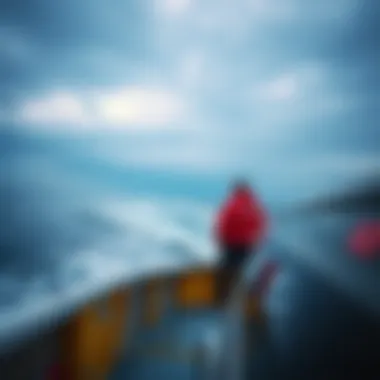

Safety Considerations
When it comes to water sports, especially those with a heightened risk like kiteboarding, safety cannot be taken lightly. It's not just the thrill of the ride that matters; it's also being aware of conditions that could compromise your safety. Understanding marine forecasts gives individuals a leg up in planning their activities, thereby mitigating some of the inherent risks.
Some notable safety considerations include:
- Hazard Currents: These can sneak up on even the most seasoned practitioners. Lake Erie often has unpredictable currents that can sweep an unsuspecting rider far from shore.
- Weather Changes: Storms can develop rapidly, leading to shifting winds and dangerous conditions. Checking the forecast can save a life, giving riders ample time to respond.
- Equipment Check: Forecasts inform equipment preparedness, including ensuring kites are suitable for predicted conditions. A mismatch here can lead to incidents.
Furthermore, kiteboarders should never underestimate the importance of having proper safety gear—like life vests and helmets. A small precaution can be the difference between a fun outing and a grim emergency.
In summary, understanding the implications of Lake Erie marine forecasts goes hand-in-hand with practicing water sports. It equips enthusiasts to ride the waves not only with a sense of pleasure but also with the most vital asset—safety. Empowering oneself with this knowledge can transform the way we immerse ourselves in the captivating dynamics of Lake Erie.
Interpreting the Forecast
Interpreting marine forecasts is crucial for any water sports enthusiast, particularly for kiteboarders who navigate the dynamic conditions of Lake Erie. Understanding these forecasts goes beyond just being able to read a weather report; it involves grasping the intricate dance of wind, waves, and weather systems that converge on the lake. A good forecast not only informs you about current conditions but also helps predict how they will evolve, which can mean the difference between an exhilarating day on the water and a hazardous situation.
Reading Marine Forecasts
When it comes to reading marine forecasts, a few elements stand out. These are the winds, wave heights, and weather patterns. Knowing how to interpret each element is vital.
- Winds: Pay attention to wind direction and speed, as these influence your kite’s performance. A reliable source for real-time wind data is the National Weather Service. The forecasts often measure wind in knots, which can give kiteboarders a clearer picture of what to expect. If you're planning to head out, ensure the wind speed is within your comfort zone, generally between 10-25 knots for most kiteboarders.
- Wave Heights: Waves can dictate the type of experience you'll have. A forecast might state that waves are 1-3 feet, which indicates a relatively calm day, perfect for beginners. Alternatively, wave heights above 4 feet can lead to choppy conditions, requiring more skill and experience.
- Weather Patterns: Keep an eye on the larger weather systems. A high-pressure system often leads to stable, sunny conditions, whereas a low-pressure system can bring storms and unpredictable weather. This is particularly important during the summer months when thunderstorms can pop up unexpectedly.
How do you put all this together? Regularly check trusted marine forecast websites like the NOAA or apps designed for water sports enthusiasts. Being able to identify key indicators of safety enhances not only your performance but also your overall enjoyment on the water.
Practical Applications for Kiteboarders
The practical applications of understanding marine forecasts for kiteboarders are numerous. Here are several considerations that kiteboarders can incorporate into their routine:
- Planning Your Sessions: A thorough interpretation of marine forecasts allows kiteboarders to plan their outings effectively. Knowing wind patterns can help select the best times and locations for kiteboarding.
- Safety Protocols: Always check the forecast before heading out. In case of rapid changes indicated by forecasts, having a solid grasp of the conditions can help prevent accidents.
- Skill Progression: For those learning, understanding forecasts can help manage expectations about what conditions are appropriate for practice. It encourages safer, more enjoyable learning experiences.
- Community Sharing: Experienced users can share weather tips and conditions through platforms like Reddit or specific kiteboarding groups on Facebook, ensuring that newer kiteboarders benefit from collective knowledge.
Understanding marine forecasts is more than just numbers; it's about making informed choices that impact your safety and enjoyment.
Ultimately, the lake is a living ecosystem, constantly changing and demanding respect. An in-depth understanding of marine forecasts can empower kiteboarders to harness the elements effectively while prioritizing safety.
Limitations of Marine Forecasts
When it comes to navigating the often unpredictable waters of Lake Erie, understanding the limitations of marine forecasts is critical. While these forecasts are immensely beneficial in planning a day out on the water, several inherent restrictions can impact their accuracy and utility. Recognizing these limitations can help water sports enthusiasts, particularly kiteboarders, better prepare for potential challenges while out on the water.
Unpredictable Weather Patterns
Weather can be as fickle as a cat on a hot tin roof. No matter how advanced the technology or how many satellites are positioned to collect data, Mother Nature often has the final say. Lake Erie is subject to sudden weather changes that can catch even the most seasoned water sports lovers off guard. One moment, the sun might be shining and wind predictions favorable, and the next, a storm could roll in, turning calm waters into choppy chaos.
- Localized Thunderstorms: Lake Erie can experience localized storms that develop quickly, particularly in the summer months. These storms might not appear on broader forecasting radars but can wreak havoc on plans for a peaceful day on the water.
- Microclimates: The topography of the surrounding areas can create microclimates, causing distinct weather differences over short distances. For instance, while it might be sunny on one section of the lake, clouds could be looming just a few miles away, leading to unforeseen weather hazards.
Ultimately, kiteboarders need to look beyond the basic forecast and stay alert to changing conditions. Keeping an eye on weather radar or utilizing apps that provide real-time updates can sometimes be a lifesaver.
Technological Limitations
Despite the advances in meteorological technology, limitations still exist. Many people assume that marine forecasts are foolproof, but that's not always true. Here are some of the key technological drawbacks:
- Data Gaps: In some regions, there may be fewer buoys or weather stations providing local data, leading to gaps in information. This means that forecasts might not fully reflect conditions on the water at any given time.
- Model Limitations: Forecast models rely on algorithms that can sometimes oversimplify complex weather systems. This inadequacy can result in inaccuracies, especially during rapidly evolving weather scenarios.
- Latency: There’s often a delay in data collection and dissemination, which can make the forecast less reliable when conditions are changing quickly. By the time information makes its way into the hands of water sports enthusiasts, it could be outdated, offering little in the way of timely preparation.
In light of these technological constraints, it’s essential for kiteboarders and other water sports participants to not only rely on forecasts but to combine them with their own observations and situational awareness. Good practices include regularly consulting various sources and remaining adaptable to changing conditions.
"While forecasts provide a foundation for planning, real-time awareness is the bedrock of safety on the water."
In summary, understanding the limitations inherent in marine forecasts is not just about acknowledging their shortcomings. Rather, it's about being informed and prepared. This knowledge allows kiteboarders and other enthusiasts to navigate Lake Erie safely and enjoyably, even when the forecast doesn’t quite align with reality.
Environmental Considerations
The Lake Erie marine forecast is not only pivotal for enthusiasts navigating its waters but also plays a crucial role in understanding the regional environment. Environmental considerations encompass a variety of elements that highlight the intricate balance between human activities and natural ecosystems. By delving into this topic, one can grasp the significant impact that weather and water conditions have—not just for human use, but also on the flora and fauna that call Lake Erie home.
Impact on Local Ecosystems
Lake Erie, the shallowest of the Great Lakes, boasts a rich tapestry of biodiversity. This includes fish species like perch and walleye, as well as various plants and habitats that thrive in its waters. However, environmental factors, including water temperature, algae blooms, and pollution levels, can greatly affect these ecosystems.
For instance, warmer temperatures can promote harmful algal blooms, which can produce toxins harmful to aquatic life. This not only affects the fish population but also disrupts food chains, leading to declines in species that rely on those fish for survival.
Additionally, pollution from urban runoff has serious implications. It can lead to diminished water quality, affecting not just human recreational activities, but also the health of the local wildlife.
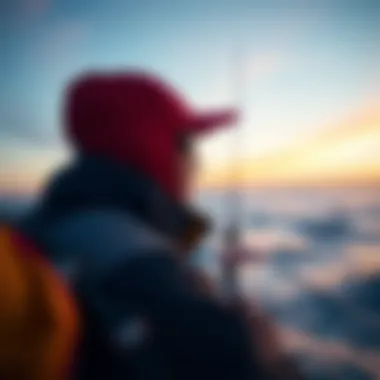

"Healthy ecosystems are vital for thriving fish populations, which in turn support local economies based on fishing and recreation."
Here’s what can happen to the ecosystems due to environmental fluctuations:
- Ecosystem Change: Species migration or decline as conditions become unsuitable.
- Water Quality: Increased algae can impact drinking water standards.
- Biodiversity Loss: Loss of native species through pollution can upend local ecological balances.
Sustainable Practices for Water Sports
To protect the delicate ecosystems in Lake Erie, it's essential for water sports enthusiasts, particularly kiteboarders, to adopt sustainable practices. These considerations go beyond mere regulation compliance, focusing instead on minimizing the impact of recreational activities on the environment. Here are several sustainable practices worth noting:
- Choose Eco-Friendly Equipment: Opt for gear that is environmentally responsible, such as biodegradable kites and boards made from recyclable materials.
- Follow Local Guidelines: Adhering to guidelines issued by local environmental agencies helps preserve habitats and reduces disturbances.
- Awareness of Wildlife: Be mindful of areas where wildlife congregates, ensuring that your activities do not disrupt their habitats.
- Clean-Up Initiatives: Participate in regular clean-up events to mitigate your footprint on the lake, helping to keep waterways clean for future generations.
By weaving sustainable practices into routine activities, enthusiasts can significantly lessen their impact on the surrounding ecosystem while enjoying the recreational opportunities Lake Erie offers. It’s about creating a synergy between pleasure and responsibility, ensuring these waters remain pristine for both current and future kiteboarders.
Technological Advances in Forecasting
The world of marine forecasting has undergone significant transformation in recent years, especially when it comes to Lake Erie. This can be attributed to advances in technology that enhance the precision and efficiency of weather predictions. For the kiteboarding community, these developments are nothing short of a game changer. With greater accuracy in forecasts, enthusiasts can make better decisions that promote safety and optimize their experience on the waters.
Emerging Technologies
Emerging technologies are the driving force behind the evolution of marine forecasts. Among these, satellite imagery and Doppler radar systems stand out. Satellite data provides real-time updates about large-scale weather patterns and has the ability to catch phenomena that might not be visible otherwise. For instance, cloud cover and precipitation can be assessed swiftly, allowing for rapid updates in forecasts.
Doppler radar, on the other hand, gives detailed insights into wind speeds and directions, which are crucial for kiteboarders who rely on specific conditions to enjoy their sport. The integration of these technologies results in more informed predictions that can have a direct impact on the timing of water activities.
Not just that, innovations like advanced modeling software are being developed to simulate weather scenarios in a multitude of combinations. This means forecasters can provide a variety of possibilities, rather than a single prediction, which is particularly helpful on a lake known for its unpredictable weather.
Community Feedback and Adaptation
Incorporating community feedback into marine forecasting has proven to be an invaluable asset. Kiteboarders, instructors, and event organizers share firsthand insights regarding local conditions. This input serves as a real-time supplement to technological forecasts, acting as a kind of ground truth that enhances predictors’ ability to deliver accurate information.
Moreover, local communities play a critical role in adapting technology for their specific needs. Many kiteboarding schools have begun to collaborate with meteorologists to develop tailored forecasts, which consider the unique microclimates around Lake Erie. These cooperative efforts can include workshops where kiteboarders learn how to interpret the forecast data themselves, fostering greater understanding and safe navigation.
"Accurate forecasts transform leisure into safety, ensuring that kiteboarders can enjoy their passion without compromising their well-being."
In summary, as advancements in forecasting technologies continue to grow, the involvement of the kiteboarding community in the adaptation of these tools will only serve to enhance their efficacy. Together, technological progress and local insights can transform marine predictions into a valuable resource for everyone on the water.
The Future of Marine Forecasting
The landscape of marine forecasting is constantly evolving, and this section will shed light on what lies ahead in predicting conditions over Lake Erie. The future is not just about improved accuracy in marine forecasts; it involves a sophisticated blend of technology and community input that could redefine how we interpret data concerning the waters. We will explore trends and predictions shaping the methodology of forecasting, while also assessing the vital role that local feedback plays in such advancements.
Trends and Predictions
The coming years promise to be significant for marine forecasting. With the rapid advancement in technology, we are seeing smarter tools that harness big data and machine learning to refine forecasts. For instance, models that analyze years of historical weather patterns combined with real-time sensor data from buoys can drastically improve prediction accuracy.
Several trends are emerging:
- Use of Artificial Intelligence: AI can analyze vast amounts of data faster than traditional methods, identifying patterns that may go unnoticed by humans. This opens doors to tailor forecasts for specific activities like kiteboarding.
- Increased Usage of Drones: Drone technology plays a role in collecting real-time data on water and weather conditions, offering insight beyond static buoys and weather stations.
- Integration of Remote Sensing Technology: Satellites can monitor everything from surface temperatures to chlorophyll concentration, providing a holistic view of the lake's environmental conditions.
- Real-time Data Sharing: Applications are now offering crowdsourced data where users can actively contribute weather observations, feeding a communal resource benefiting everyone involved in water sports.
These trends verify the idea that forecasting will become more responsive and fine-tuned. Each kiteboarder or sailor can expect data that not only reflects broader patterns but mirrors immediate, on-the-ground changes.
Role of Community Input
Community engagement forms the backbone of robust marine forecasting. The input from local users not only provides invaluable real-world data but also fosters a sense of shared responsibility towards lake safety.
- Feedback Systems: Local sailors and kiteboarders are uniquely positioned to offer feedback that can significantly enhance forecast models. Reporting conditions they experience can help improve accuracy.
- Workshops and Trainings: Engaging community members through workshops can educate them about how to interpret forecasts better and provide insights that meteorologists find crucial. This creates a loop of communication that benefits everyone.
- Citizen Science Initiatives: These programs enable enthusiasts to contribute to scientific studies, often yielding meaningful results. By participating, they become stakeholders in the health of Lake Erie, which directly affects their chosen activities.
- Building Trust: When communities feel involved in the forecasting process, they are more likely to trust the information provided. This trust translates to safer practices on the water, significantly reducing risks associated with sudden weather changes.
Moving forward, the dual advancement of technology and community involvement will empower all who interact with Lake Erie’s waters. This synergy is not merely about improving forecasts; it’s about creating a culture of awareness and safety that reinforces informed decision-making. It’s imperative that both advancements continue in tandem, shaping the future of marine forecasting into a resource that is trustworthy, insightful, and incredibly beneficial for everyone who shares a passion for Lake Erie.
Finale
As we draw the curtain on our exploration of the Lake Erie marine forecast, it's essential to highlight just how crucial these insights are for anyone venturing onto the waters. This summary encapsulates the essence of our discussion, emphasizing the key benefits and considerations related to understanding these forecasts.
Summarizing Key Insights
Looking back, the marine forecast serves as a cornerstone for safe navigation on Lake Erie, especially for kiteboarders and other water sport enthusiasts. The main takeaways include:
- Accuracy of Predictions: Utilizing data from satellites, buoys, and weather stations contributes to reliable forecasts—a necessity for making informed decisions.
- Understanding Weather Patterns: Knowledge of wind dynamics, wave heights, and storm warnings directly impacts safety and performance on the water.
- Environmental Implications: Recognizing how weather conditions affect local ecosystems is crucial for implementing sustainable practices in water sports.
- Technological Advances: Keeping up-to-date with emerging technologies, such as predictive algorithms and community feedback, can enhance the forecasting process.
These insights serve not only to prepare water enthusiasts but also to foster a culture of safety and responsibility on Lake Erie.
Final Thoughts on Safe Navigation
Navigating the waters of Lake Erie safely demands more than just enthusiasm; it's about understanding the environment and respecting the unpredictable nature of weather. Takeaways like checking forecasts before heading out and remaining flexible with plans can greatly reduce risks. After all, when kiteboarding or engaging in any water sport, it's generally about balancing thrill with caution. The aim should always be to maximize enjoyment while minimizing hazards.
For further information regarding best practices in safety and techniques for kiteboarding, visit National Weather Service or explore different forums on Reddit. This way, one can glean insights from fellow enthusiasts and experts, ensuring a well-rounded understanding of how to navigate in harmony with nature.










